The Cambridge History of Japan, Vol. 4: Early Modern Japan
Подождите немного. Документ загружается.

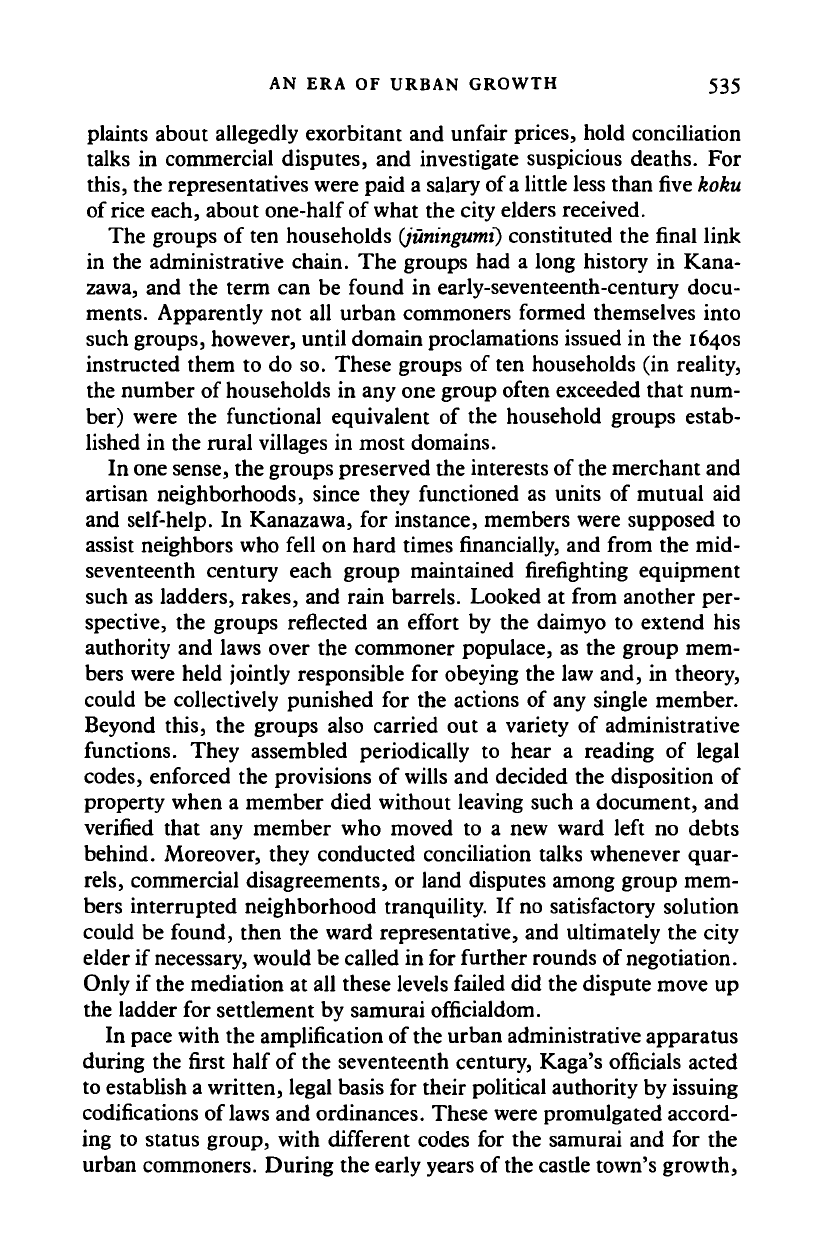
AN ERA OF URBAN GROWTH 535
plaints about allegedly exorbitant and unfair prices, hold conciliation
talks in commercial disputes, and investigate suspicious deaths. For
this,
the representatives were paid a salary of a little less than
five
koku
of
rice
each, about one-half of what the city elders received.
The groups of ten households
(juningumi)
constituted the final link
in the administrative chain. The groups had a long history in Kana-
zawa, and the term can be found in early-seventeenth-century docu-
ments. Apparently not all urban commoners formed themselves into
such groups, however, until domain proclamations issued in the 1640s
instructed them to do so. These groups of ten households (in reality,
the number of households in any one group often exceeded that num-
ber) were the functional equivalent of the household groups estab-
lished in the rural villages in most domains.
In one sense, the groups preserved the interests of the merchant and
artisan neighborhoods, since they functioned as units of mutual aid
and self-help. In Kanazawa, for instance, members were supposed to
assist neighbors who fell on hard times
financially,
and from the mid-
seventeenth century each group maintained firefighting equipment
such as ladders, rakes, and rain barrels. Looked at from another per-
spective, the groups reflected an effort by the daimyo to extend his
authority and laws over the commoner populace, as the group mem-
bers were held jointly responsible for obeying the law and, in theory,
could be collectively punished for the actions of any single member.
Beyond this, the groups also carried out a variety of administrative
functions. They assembled periodically to hear a reading of legal
codes,
enforced the provisions of wills and decided the disposition of
property when a member died without leaving such a document, and
verified that any member who moved to a new ward left no debts
behind. Moreover, they conducted conciliation talks whenever quar-
rels,
commercial disagreements, or land disputes among group mem-
bers interrupted neighborhood tranquility. If no satisfactory solution
could be found, then the ward representative, and ultimately the city
elder if
necessary,
would be called in for further rounds of negotiation.
Only if the mediation at all these levels failed did the dispute move up
the ladder for settlement by samurai officialdom.
In pace with the amplification of the urban administrative apparatus
during the first half of the seventeenth century, Kaga's officials acted
to establish a written, legal basis for their political authority by issuing
codifications of
laws
and ordinances. These were promulgated accord-
ing to status group, with different codes for the samurai and for the
urban commoners. During the early years of
the
castle town's growth,
Cambridge Histories Online © Cambridge University Press, 2008
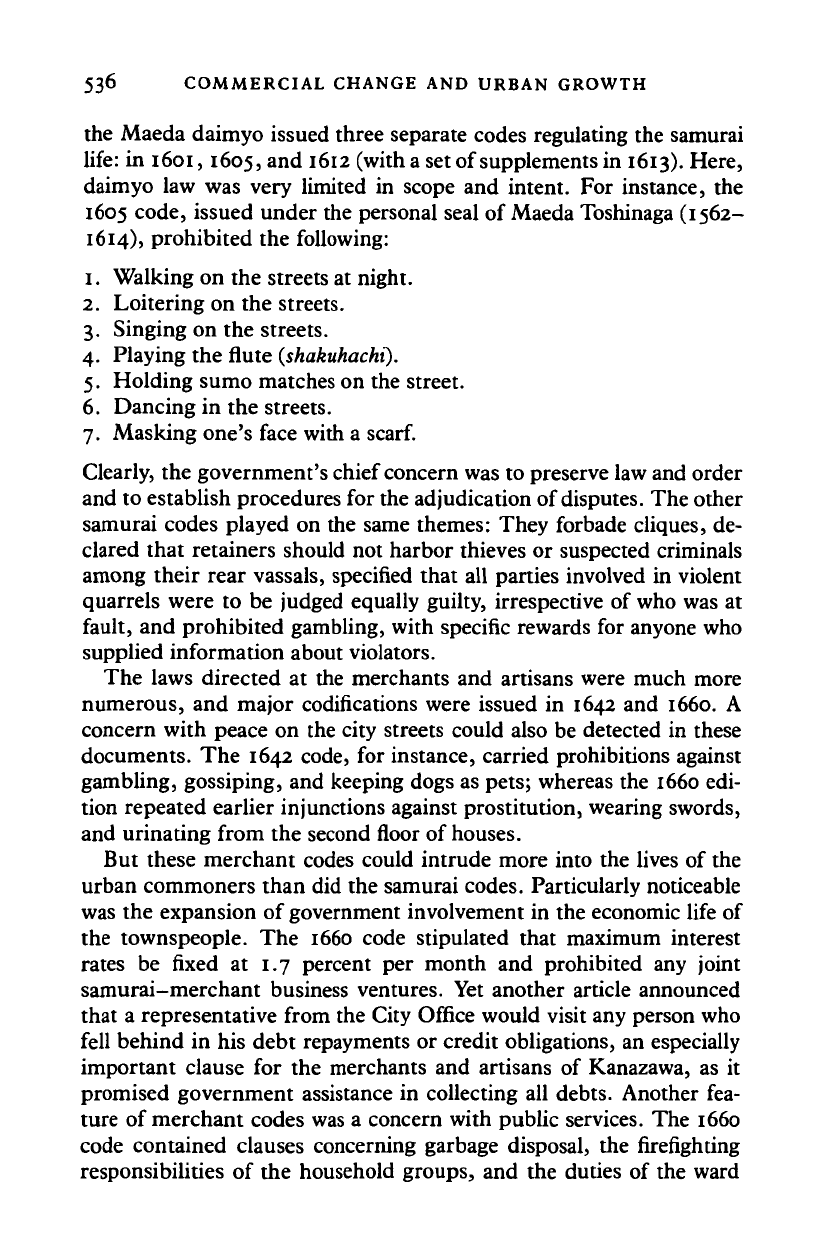
536 COMMERCIAL CHANGE AND URBAN GROWTH
the Maeda daimyo issued three separate codes regulating the samurai
life:
in 1601,1605, and 1612 (with a set of supplements in 1613). Here,
daimyo law was very limited in scope and intent. For instance, the
1605 code, issued under the personal seal of Maeda Toshinaga (1562-
1614),
prohibited the following:
1.
Walking on the streets at night.
2.
Loitering on the streets.
3.
Singing on the streets.
4.
Playing the flute
(shakuhachi).
5.
Holding sumo matches on the street.
6. Dancing in the streets.
7.
Masking one's face with a
scarf.
Clearly, the government's chief concern was to preserve law and order
and to establish procedures for the adjudication of disputes. The other
samurai codes played on the same themes: They forbade cliques, de-
clared that retainers should not harbor thieves or suspected criminals
among their rear vassals, specified that all parties involved in violent
quarrels were to be judged equally guilty, irrespective of who was at
fault, and prohibited gambling, with specific rewards for anyone who
supplied information about violators.
The laws directed at the merchants and artisans were much more
numerous, and major codifications were issued in 1642 and 1660. A
concern with peace on the city streets could also be detected in these
documents. The 1642 code, for instance, carried prohibitions against
gambling, gossiping, and keeping dogs as pets; whereas the 1660 edi-
tion repeated earlier injunctions against prostitution, wearing swords,
and urinating from the second floor of houses.
But these merchant codes could intrude more into the lives of the
urban commoners than did the samurai codes. Particularly noticeable
was the expansion of government involvement in the economic life of
the townspeople. The 1660 code stipulated that maximum interest
rates be fixed at 1.7 percent per month and prohibited any joint
samurai-merchant business ventures. Yet another article announced
that a representative from the City Office would visit any person who
fell behind in his debt repayments or credit obligations, an especially
important clause for the merchants and artisans of Kanazawa, as it
promised government assistance in collecting all debts. Another fea-
ture of merchant codes was a concern with public services. The 1660
code contained clauses concerning garbage disposal, the firefighting
responsibilities of the household groups, and the duties of the ward
Cambridge Histories Online © Cambridge University Press, 2008
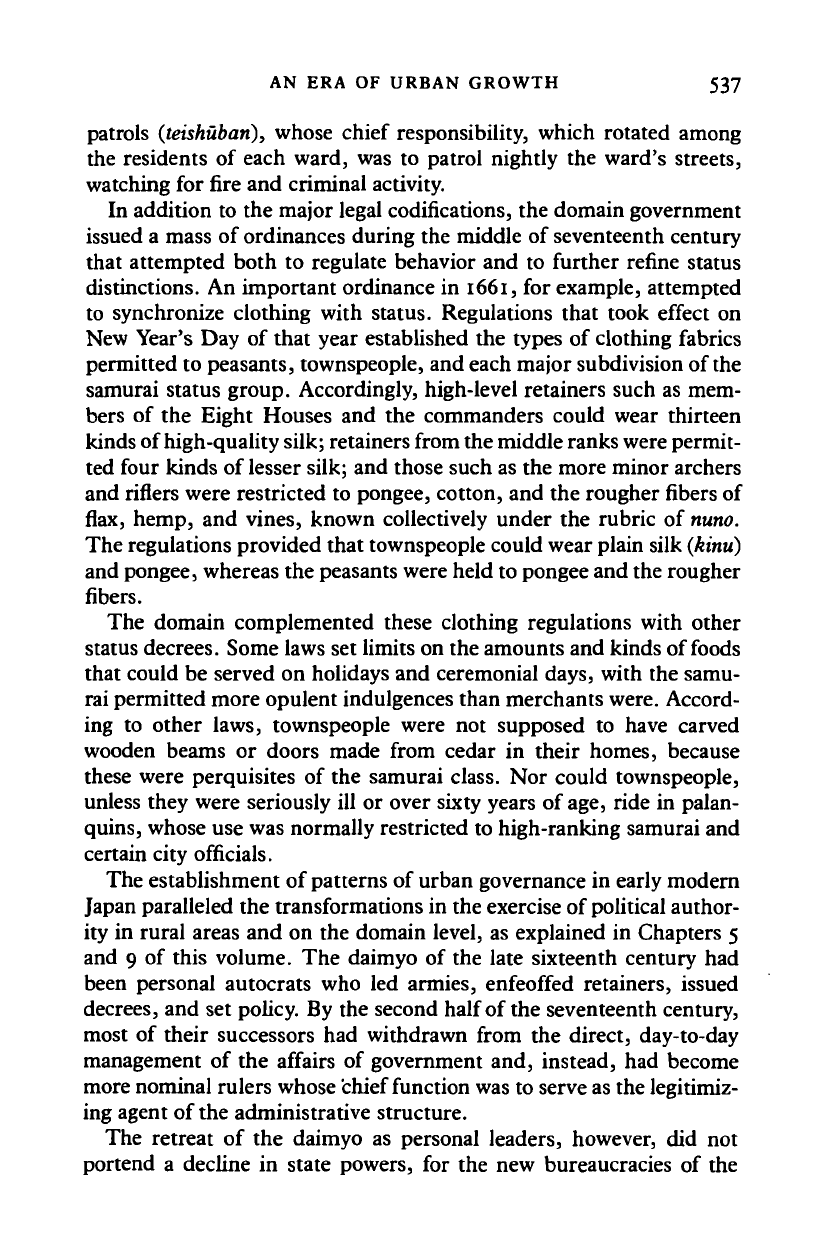
AN ERA OF URBAN GROWTH 537
patrols
(teishubari),
whose chief responsibility, which rotated among
the residents of each ward, was to patrol nightly the ward's streets,
watching for fire and criminal activity.
In addition to the major legal codifications, the domain government
issued a mass of ordinances during the middle of seventeenth century
that attempted both to regulate behavior and to further refine status
distinctions. An important ordinance in
1661,
for example, attempted
to synchronize clothing with status. Regulations that took effect on
New Year's Day of that year established the types of clothing fabrics
permitted to peasants, townspeople, and each major subdivision of the
samurai status group. Accordingly, high-level retainers such as mem-
bers of the Eight Houses and the commanders could wear thirteen
kinds of high-quality
silk;
retainers from the middle ranks were permit-
ted four kinds of lesser silk; and those such as the more minor archers
and riflers were restricted to pongee, cotton, and the rougher fibers of
flax, hemp, and vines, known collectively under the rubric of
nuno.
The regulations provided that townspeople could wear plain silk
(kinu)
and pongee, whereas the peasants were held to pongee and the rougher
fibers.
The domain complemented these clothing regulations with other
status decrees. Some laws set limits on the amounts and kinds of foods
that could be served on holidays and ceremonial days, with the samu-
rai permitted more opulent indulgences than merchants were. Accord-
ing to other laws, townspeople were not supposed to have carved
wooden beams or doors made from cedar in their homes, because
these were perquisites of the samurai class. Nor could townspeople,
unless they were seriously ill or over sixty years of
age,
ride in palan-
quins,
whose use was normally restricted to high-ranking samurai and
certain city officials.
The establishment of patterns of urban governance in early modern
Japan paralleled the transformations in the exercise of political author-
ity in rural areas and on the domain level, as explained in Chapters 5
and 9 of this volume. The daimyo of the late sixteenth century had
been personal autocrats who led armies, enfeoffed retainers, issued
decrees, and set policy. By the second half of the seventeenth century,
most of their successors had withdrawn from the direct, day-to-day
management of the affairs of government and, instead, had become
more nominal rulers whose chief function was to serve as the legitimiz-
ing agent of the administrative structure.
The retreat of the daimyo as personal leaders, however, did not
portend a decline in state powers, for the new bureaucracies of the
Cambridge Histories Online © Cambridge University Press, 2008
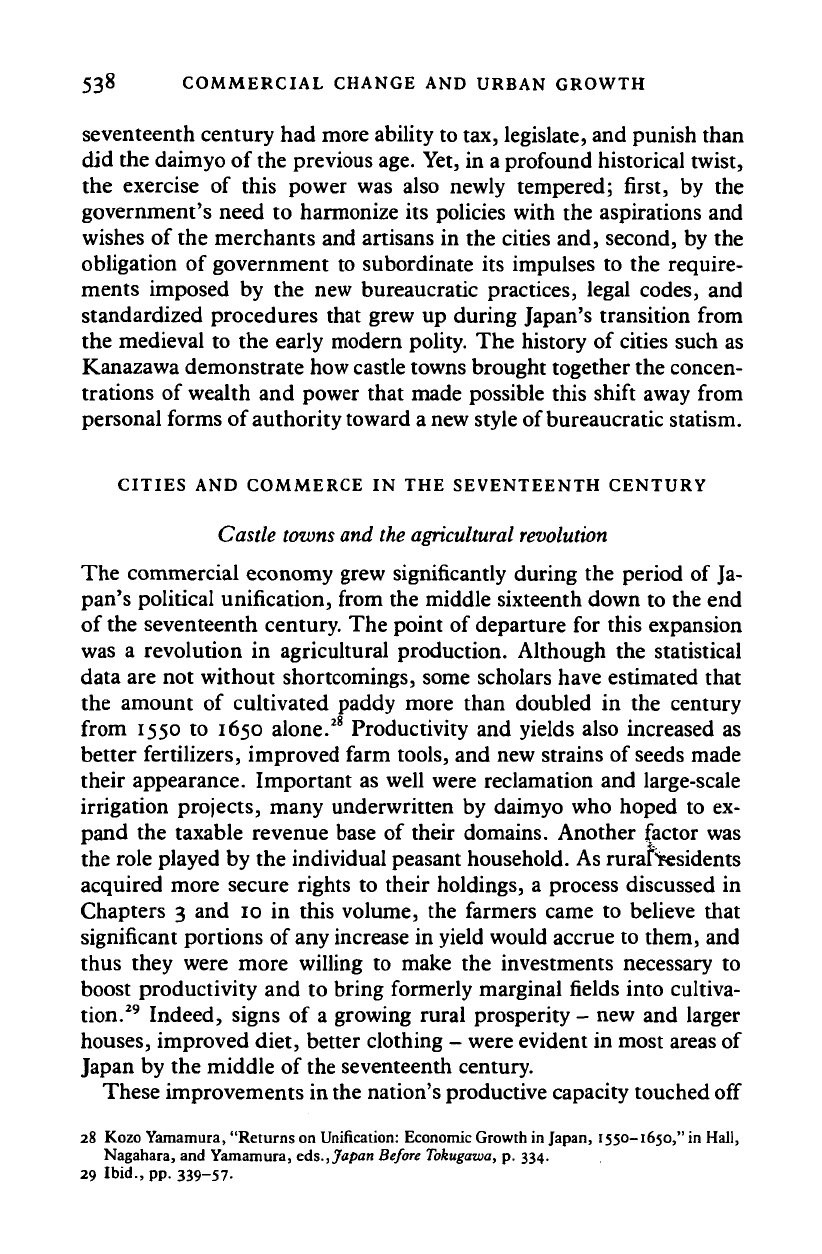
538 COMMERCIAL CHANGE AND URBAN GROWTH
seventeenth century had more ability to tax, legislate, and punish than
did the daimyo of the previous
age.
Yet, in a profound historical twist,
the exercise of this power was also newly tempered; first, by the
government's need to harmonize its policies with the aspirations and
wishes of the merchants and artisans in the cities and, second, by the
obligation of government to subordinate its impulses to the require-
ments imposed by the new bureaucratic practices, legal codes, and
standardized procedures that grew up during Japan's transition from
the medieval to the early modern polity. The history of cities such as
Kanazawa demonstrate how castle towns brought together the concen-
trations of wealth and power that made possible this shift away from
personal forms of authority toward a new style of bureaucratic statism.
CITIES AND COMMERCE IN THE SEVENTEENTH CENTURY
Castle towns and the agricultural revolution
The commercial economy grew significantly during the period of Ja-
pan's political unification, from the middle sixteenth down to the end
of the seventeenth century. The point of departure for this expansion
was a revolution in agricultural production. Although the statistical
data are not without shortcomings, some scholars have estimated that
the amount of cultivated paddy more than doubled in the century
from 1550 to 1650 alone.
28
Productivity and yields also increased as
better fertilizers, improved farm tools, and new strains of seeds made
their appearance. Important as well were reclamation and large-scale
irrigation projects, many underwritten by daimyo who hoped to ex-
pand the taxable revenue base of their domains. Another (actor was
the role played by the individual peasant household. As ruran?esidents
acquired more secure rights to their holdings, a process discussed in
Chapters 3 and 10 in this volume, the farmers came to believe that
significant portions of any increase in yield would accrue to them, and
thus they were more willing to make the investments necessary to
boost productivity and to bring formerly marginal fields into cultiva-
tion.
29
Indeed, signs of a growing rural prosperity - new and larger
houses, improved diet, better clothing - were evident in most areas of
Japan by the middle of the seventeenth century.
These improvements in the nation's productive capacity touched off
28 Kozo Yamamura, "Returns
on
Unification: Economic Growth
in
Japan, 1550-1650,"
in
Hall,
Nagahara,
and
Yamamura,
eds.,
Japan
Before
Tokugawa,
p. 334.
29 Ibid.,
pp.
339-57-
Cambridge Histories Online © Cambridge University Press, 2008
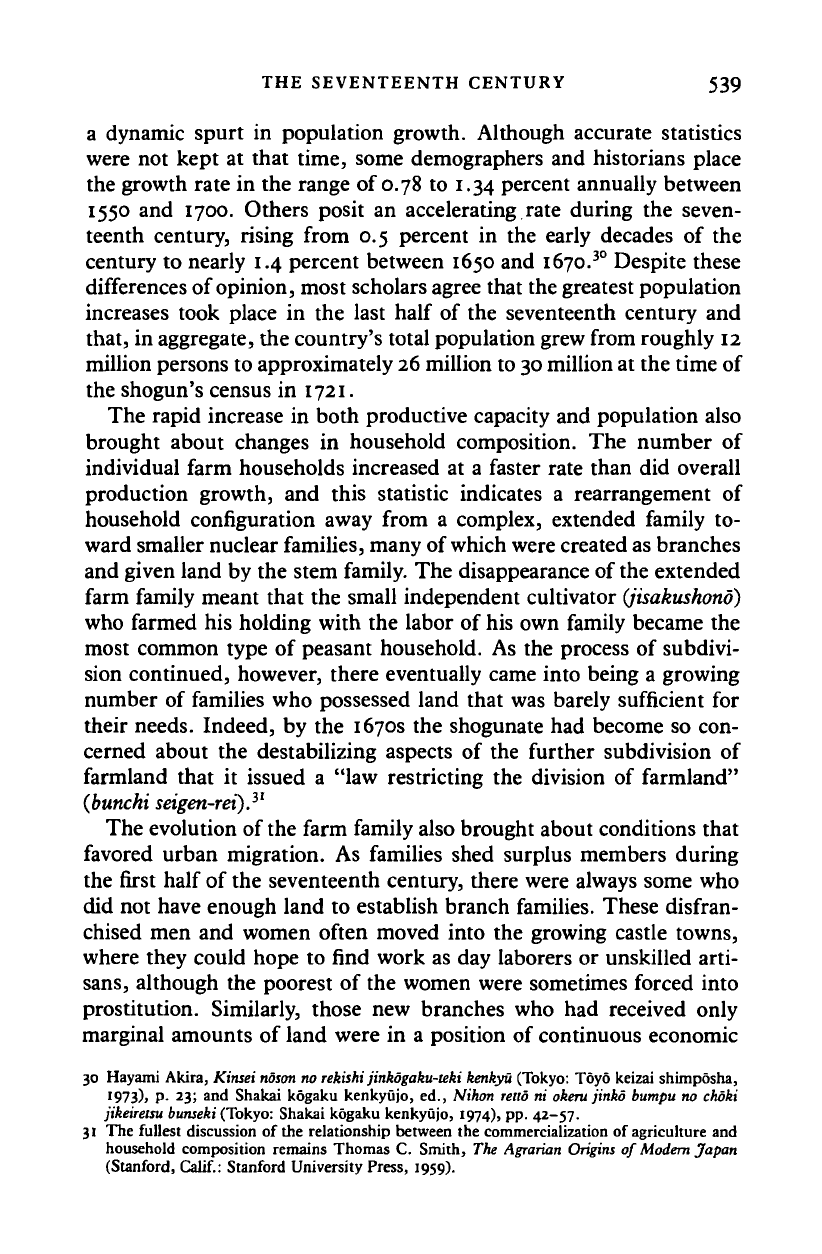
THE SEVENTEENTH CENTURY 539
a dynamic spurt in population growth. Although accurate statistics
were not kept at that time, some demographers and historians place
the growth rate in the range of 0.78 to 1.34 percent annually between
1550 and 1700. Others posit an accelerating rate during the seven-
teenth century, rising from 0.5 percent in the early decades of the
century to nearly 1.4 percent between 1650 and 1670.
3
° Despite these
differences of opinion, most scholars agree that the greatest population
increases took place in the last half of the seventeenth century and
that, in aggregate, the country's total population grew from roughly 12
million persons to approximately 26 million to
30
million at the time of
the shogun's census in 1721.
The rapid increase in both productive capacity and population also
brought about changes in household composition. The number of
individual farm households increased at a faster rate than did overall
production growth, and this statistic indicates a rearrangement of
household configuration away from a complex, extended family to-
ward smaller nuclear families, many of which were created as branches
and given land by the stem family. The disappearance of the extended
farm family meant that the small independent cultivator
(jisakushono)
who farmed his holding with the labor of his own family became the
most common type of peasant household. As the process of subdivi-
sion continued, however, there eventually came into being a growing
number of families who possessed land that was barely sufficient for
their needs. Indeed, by the 1670s the shogunate had become so con-
cerned about the destabilizing aspects of the further subdivision of
farmland that it issued a "law restricting the division of farmland"
{bunchi
seigen-rei).
1
'
The evolution of the farm family also brought about conditions that
favored urban migration. As families shed surplus members during
the first half of the seventeenth century, there were always some who
did not have enough land to establish branch families. These disfran-
chised men and women often moved into the growing castle towns,
where they could hope to find work as day laborers or unskilled arti-
sans,
although the poorest of the women were sometimes forced into
prostitution. Similarly, those new branches who had received only
marginal amounts of land were in a position of continuous economic
30 Hayami Akira, Kinsei
ndson
no
rekishi
jinkogaku-teki
kenkyu
(Tokyo: Toyo keizai shimposha,
1973),
p. 23; and Shakai kogaku kenkyujo, ed., Nihon relto ni
okeru
jinko bumpu no choki
jikeiretsu
bunseki
(Tokyo: Shakai kogaku kenkyujo, 1974), pp. 42-57.
31 The fullest discussion of the relationship between the commercialization of agriculture and
household composition remains Thomas C. Smith, The Agrarian Origins of Modem Japan
(Stanford,
Calif.:
Stanford University Press, 1959).
Cambridge Histories Online © Cambridge University Press, 2008
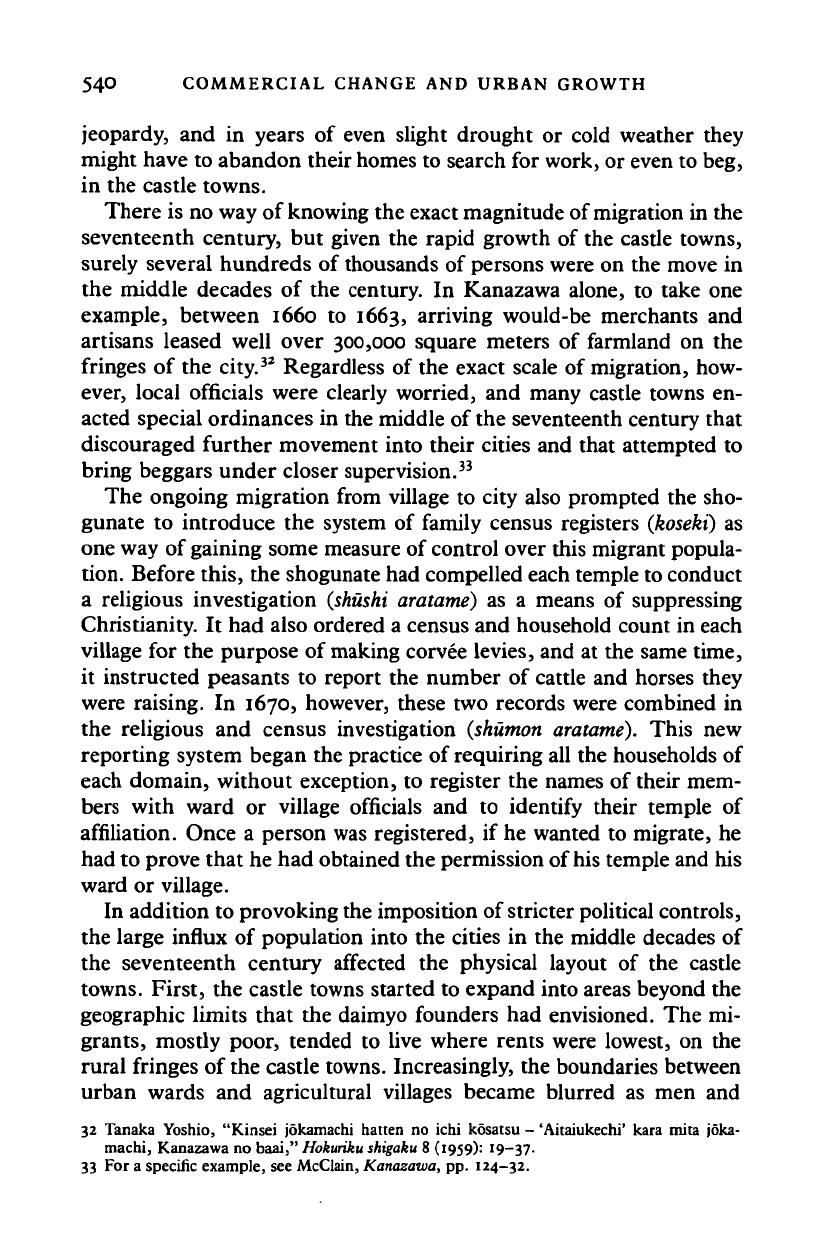
540 COMMERCIAL CHANGE AND URBAN GROWTH
jeopardy, and in years of even slight drought or cold weather they
might have to abandon their homes to search for work, or even to beg,
in the castle towns.
There is no way of knowing the exact magnitude of migration in the
seventeenth century, but given the rapid growth of the castle towns,
surely several hundreds of thousands of persons were on the move in
the middle decades of the century. In Kanazawa alone, to take one
example, between 1660 to 1663, arriving would-be merchants and
artisans leased well over 300,000 square meters of farmland on the
fringes of the city.
32
Regardless of the exact scale of migration, how-
ever, local officials were clearly worried, and many castle towns en-
acted special ordinances in the middle of the seventeenth century that
discouraged further movement into their cities and that attempted to
bring beggars under closer supervision.
33
The ongoing migration from village to city also prompted the sho-
gunate to introduce the system of family census registers
(koseki)
as
one way of gaining some measure of control over this migrant popula-
tion. Before this, the shogunate had compelled each temple to conduct
a religious investigation
(shushi aratame)
as a means of suppressing
Christianity. It had also ordered a census and household count in each
village for the purpose of making corvee levies, and at the same time,
it instructed peasants to report the number of cattle and horses they
were raising. In 1670, however, these two records were combined in
the religious and census investigation (shumon
aratame).
This new
reporting system began the practice of requiring all the households of
each domain, without exception, to register the names of their mem-
bers with ward or village officials and to identify their temple of
affiliation. Once a person was registered, if he wanted to migrate, he
had to prove that he had obtained the permission of
his
temple and his
ward or village.
In addition to provoking the imposition of stricter political controls,
the large influx of population into the cities in the middle decades of
the seventeenth century affected the physical layout of the castle
towns. First, the castle towns started to expand into areas beyond the
geographic limits that the daimyo founders had envisioned. The mi-
grants, mostly poor, tended to live where rents were lowest, on the
rural fringes of the castle towns. Increasingly, the boundaries between
urban wards and agricultural villages became blurred as men and
32 Tanaka Yoshio, "Kinsei jokamachi hatten no ichi kosatsu - 'Aitaiukechi' kara mita joka-
machi, Kanazawa no baai,"
Hokunku shigaku
8 (1959): 19-37.
33 For a specific example, see McClain, Kanazawa, pp. 124-32.
Cambridge Histories Online © Cambridge University Press, 2008
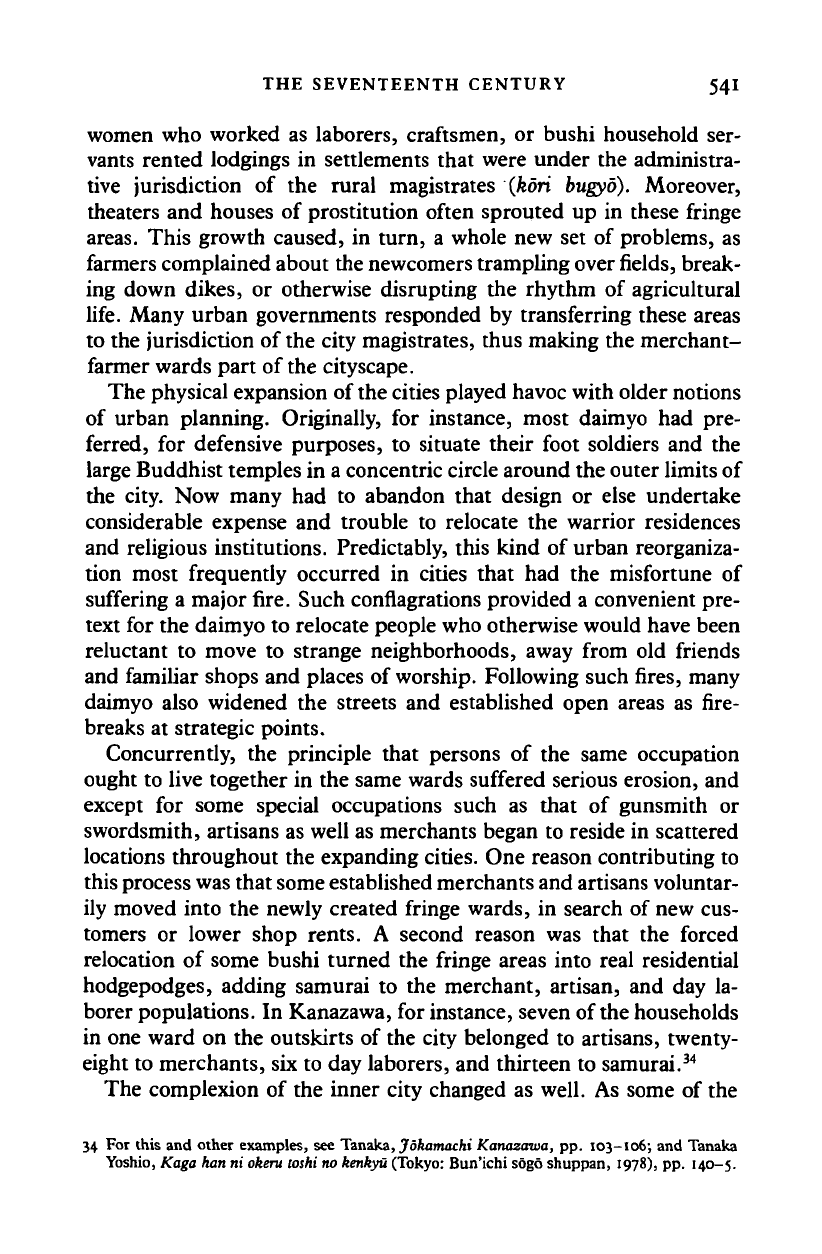
THE SEVENTEENTH CENTURY 541
women who worked as laborers, craftsmen, or bushi household ser-
vants rented lodgings in settlements that were under the administra-
tive jurisdiction of the rural magistrates
(Jkori
bugyo). Moreover,
theaters and houses of prostitution often sprouted up in these fringe
areas.
This growth caused, in turn, a whole new set of problems, as
farmers complained about the newcomers trampling over fields, break-
ing down dikes, or otherwise disrupting the rhythm of agricultural
life.
Many urban governments responded by transferring these areas
to the jurisdiction of the city magistrates, thus making the merchant-
farmer wards part of the cityscape.
The physical expansion of the cities played havoc with older notions
of urban planning. Originally, for instance, most daimyo had pre-
ferred, for defensive purposes, to situate their foot soldiers and the
large Buddhist temples in a concentric circle around the outer limits of
the city. Now many had to abandon that design or else undertake
considerable expense and trouble to relocate the warrior residences
and religious institutions. Predictably, this kind of urban reorganiza-
tion most frequently occurred in cities that had the misfortune of
suffering a major fire. Such conflagrations provided a convenient pre-
text for the daimyo to relocate people who otherwise would have been
reluctant to move to strange neighborhoods, away from old friends
and familiar shops and places of
worship.
Following such fires, many
daimyo also widened the streets and established open areas as fire-
breaks at strategic points.
Concurrently, the principle that persons of the same occupation
ought to live together in the same wards suffered serious erosion, and
except for some special occupations such as that of gunsmith or
swordsmith, artisans as well as merchants began to reside in scattered
locations throughout the expanding cities. One reason contributing to
this process was that some established merchants and artisans voluntar-
ily moved into the newly created fringe wards, in search of new cus-
tomers or lower shop rents. A second reason was that the forced
relocation of some bushi turned the fringe areas into real residential
hodgepodges, adding samurai to the merchant, artisan, and day la-
borer populations. In Kanazawa, for instance, seven of the households
in one ward on the outskirts of the city belonged to artisans, twenty-
eight to merchants, six to day laborers, and thirteen to samurai.
34
The complexion of the inner city changed as well. As some of the
34 For this and other examples, see Tanaka, Jokamachi Kanazawa, pp. 103-106; and Tanaka
Yoshio, Kaga
hart
ni
okeru toshi
no
kenkyu
(Tokyo: Bun'ichi sogo shuppan, 1978), pp. 140-5.
Cambridge Histories Online © Cambridge University Press, 2008
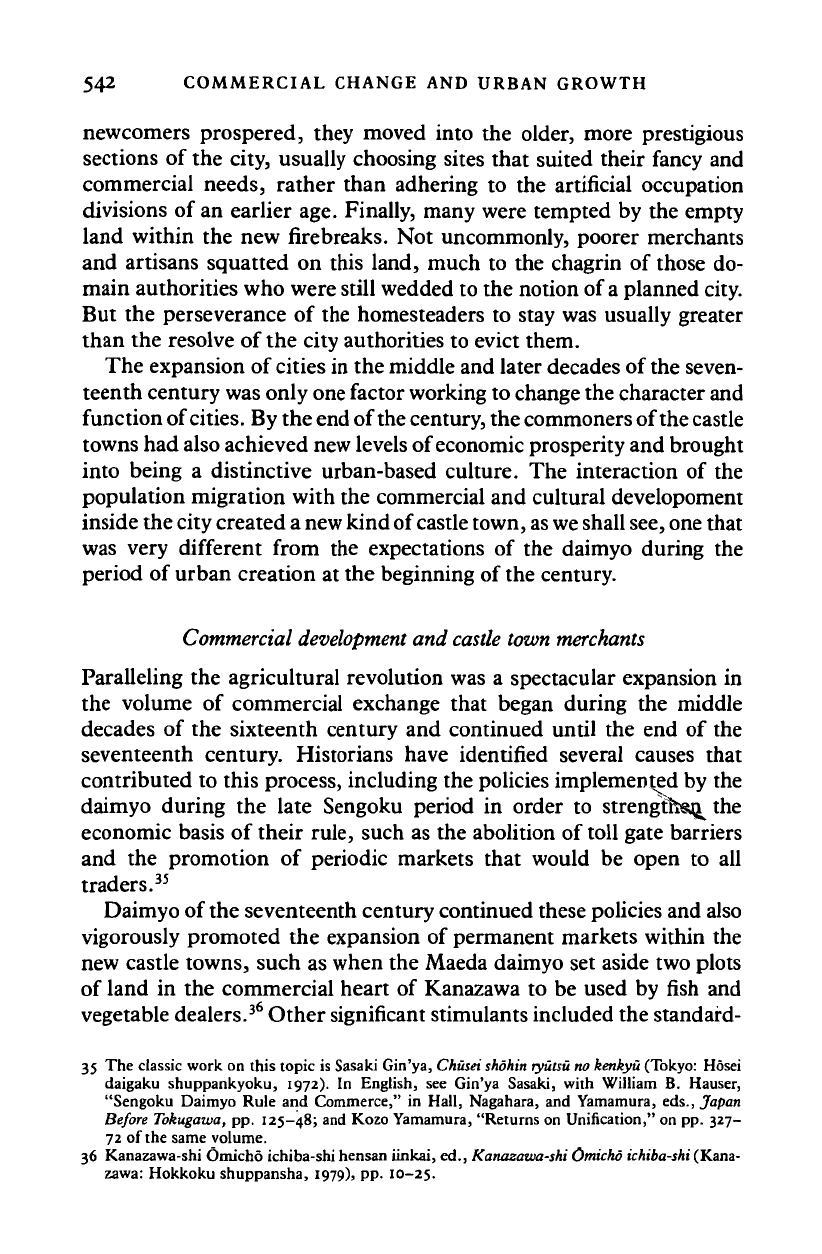
542 COMMERCIAL CHANGE
AND
URBAN GROWTH
newcomers prospered, they moved into
the
older, more prestigious
sections
of the
city, usually choosing sites that suited their fancy
and
commercial needs, rather than adhering
to the
artificial occupation
divisions
of an
earlier age. Finally, many were tempted
by the
empty
land within
the new
firebreaks.
Not
uncommonly, poorer merchants
and artisans squatted
on
this land, much
to the
chagrin
of
those
do-
main authorities who were still wedded
to the
notion
of
a
planned city.
But
the
perseverance
of the
homesteaders
to
stay
was
usually greater
than
the
resolve
of
the city authorities
to
evict them.
The expansion
of
cities
in
the middle
and
later decades
of
the seven-
teenth century was only
one
factor working to change the character and
function of
cities.
By the end of the century, the commoners of the castle
towns
had
also achieved new levels of economic prosperity and brought
into being
a
distinctive urban-based culture.
The
interaction
of the
population migration with
the
commercial
and
cultural developoment
inside the city created
a new
kind of castle town,
as we
shall
see,
one that
was very different from
the
expectations
of the
daimyo during
the
period
of
urban creation
at the
beginning
of
the century.
Commercial development
and
castle
town merchants
Paralleling
the
agricultural revolution
was a
spectacular expansion
in
the volume
of
commercial exchange that began during
the
middle
decades
of the
sixteenth century
and
continued until
the end of the
seventeenth century. Historians have identified several causes that
contributed
to
this process, including
the
policies implemented
by the
daimyo during
the
late Sengoku period
in
order
to
strength^
the
economic basis
of
their rule, such
as the
abolition
of
toll gate barriers
and
the
promotion
of
periodic markets that would
be
open
to all
traders.
35
Daimyo of the seventeenth century continued these policies
and
also
vigorously promoted
the
expansion
of
permanent markets within
the
new castle towns, such
as
when
the
Maeda daimyo
set
aside two plots
of land
in the
commercial heart
of
Kanazawa
to be
used
by
fish
and
vegetable dealers.
36
Other significant stimulants included the standard-
35 The classic work on this topic is Sasaki Gin'ya,
Chusei shohin ryutsu
no
kenkyu (Tokyo: Hosei
daigaku shuppankyoku, 1972). In English, see Gin'ya Sasaki, with William B. Hauser,
"Sengoku Daimyo Rule and Commerce," in Hall, Nagahara, and Yamamura, eds., Japan
Before Tokugawa, pp. 125-48; and Kozo Yamamura, "Returns on Unification," on pp. 327-
72 of the same volume.
36 Kanazawa-shi Omicho ichiba-shi hensan iinkai, ed., Kanazawa-shi
Omicho ichiba-shi
(Kana-
zawa: Hokkoku shuppansha, 1979), pp.
10-25.
Cambridge Histories Online © Cambridge University Press, 2008
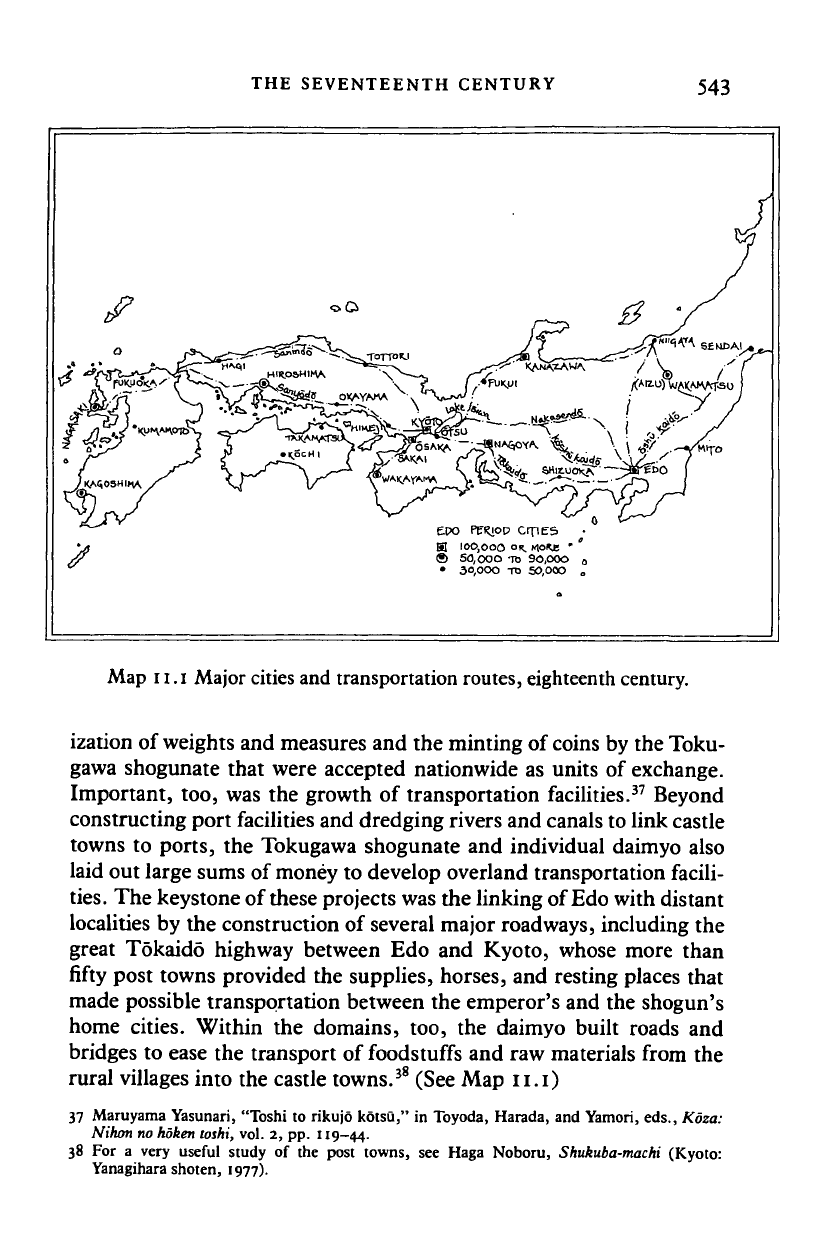
THE SEVENTEENTH CENTURY
543
EDO
BI 100,000 °K.
NIORJ;
•"
"
® 50,000
-TO
90,000
0
• 30,000 -ro 50,000 „
Map
11.1
Major cities and transportation
routes,
eighteenth century.
ization of weights and measures and the minting of
coins
by the Toku-
gawa shogunate that were accepted nationwide as units of exchange.
Important, too, was the growth of transportation facilities.
37
Beyond
constructing port facilities and dredging rivers and canals to link castle
towns to ports, the Tokugawa shogunate and individual daimyo also
laid out large sums of money to develop overland transportation facili-
ties.
The keystone of these projects was the linking of Edo with distant
localities by the construction of several major roadways, including the
great Tokaido highway between Edo and Kyoto, whose more than
fifty post towns provided the supplies, horses, and resting places that
made possible transportation between the emperor's and the shogun's
home cities. Within the domains, too, the daimyo built roads and
bridges to ease the transport of foodstuffs and raw materials from the
rural villages into the castle towns.
38
(See Map n.i)
37 Maruyama Yasunari, "Toshi to rikujo kotsu," in Toyoda, Harada, and Yamori, eds., Koza:
Nihon no
hdken
toshi, vol. 2, pp. 119-44.
38 For a very useful study of the post towns, see Haga Noboru, Shukuba-machi (Kyoto:
Yanagihara shoten, 1977).
Cambridge Histories Online © Cambridge University Press, 2008
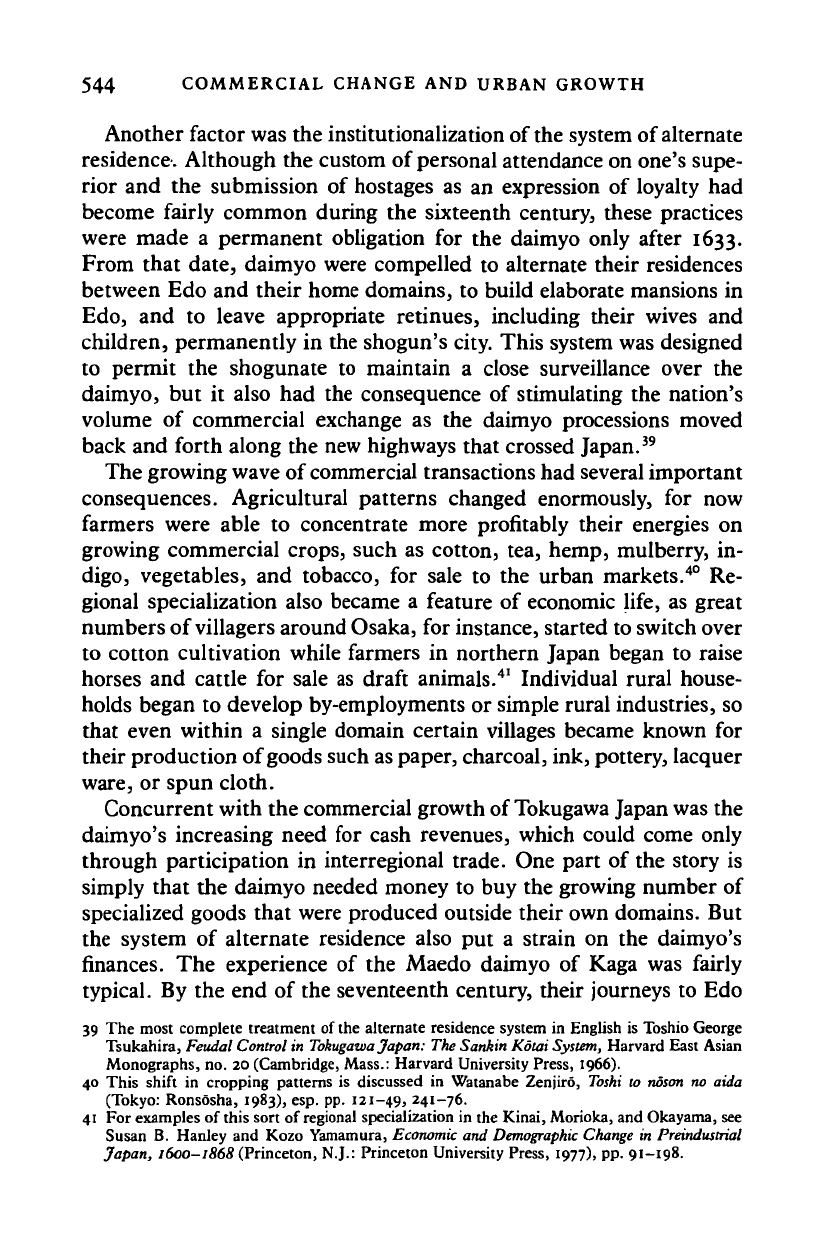
544 COMMERCIAL CHANGE AND URBAN GROWTH
Another factor was the institutionalization of
the
system of alternate
residence. Although the custom of personal attendance on one's supe-
rior and the submission of hostages as an expression of loyalty had
become fairly common during the sixteenth century, these practices
were made a permanent obligation for the daimyo only after 1633.
From that date, daimyo were compelled to alternate their residences
between Edo and their home domains, to build elaborate mansions in
Edo,
and to leave appropriate retinues, including their wives and
children, permanently in the shogun's city. This system was designed
to permit the shogunate to maintain a close surveillance over the
daimyo, but it also had the consequence of stimulating the nation's
volume of commercial exchange as the daimyo processions moved
back and forth along the new highways that crossed Japan.
39
The growing wave of commercial transactions had several important
consequences. Agricultural patterns changed enormously, for now
farmers were able to concentrate more profitably their energies on
growing commercial crops, such as cotton, tea, hemp, mulberry, in-
digo,
vegetables, and tobacco, for sale to the urban markets.
40
Re-
gional specialization also became a feature of economic life, as great
numbers of villagers around Osaka, for instance, started to switch over
to cotton cultivation while farmers in northern Japan began to raise
horses and cattle for sale as draft animals.
41
Individual rural house-
holds began to develop by-employments or simple rural industries, so
that even within a single domain certain villages became known for
their production of goods such as paper, charcoal, ink, pottery, lacquer
ware, or spun cloth.
Concurrent with the commercial growth of Tokugawa Japan was the
daimyo's increasing need for cash revenues, which could come only
through participation in interregional trade. One part of the story is
simply that the daimyo needed money to buy the growing number of
specialized goods that were produced outside their own domains. But
the system of alternate residence also put a strain on the daimyo's
finances. The experience of the Maedo daimyo of Kaga was fairly
typical. By the end of the seventeenth century, their journeys to Edo
39 The most complete treatment of the alternate residence system in English is Toshio George
Tsukahira, Feudal Control in Tokugawa Japan: The Sankin Kotai System, Harvard East Asian
Monographs, no. 20 (Cambridge, Mass.: Harvard University Press, 1966).
40 This shift in cropping patterns is discussed in Watanabe Zenjiro, Toshi to noson no aida
(Tokyo: Ronsosha, 1983), esp. pp. 121-49, 241-76.
41 For examples of this sort of regional specialization in the Kinai, Morioka, and Okayama, see
Susan B. Hanley and Kozo Yamamura, Economic and
Demographic
Change in Preindustrial
Japan, 1600-1868 (Princeton, N.J.: Princeton University Press, 1977), pp. 91-198.
Cambridge Histories Online © Cambridge University Press, 2008
